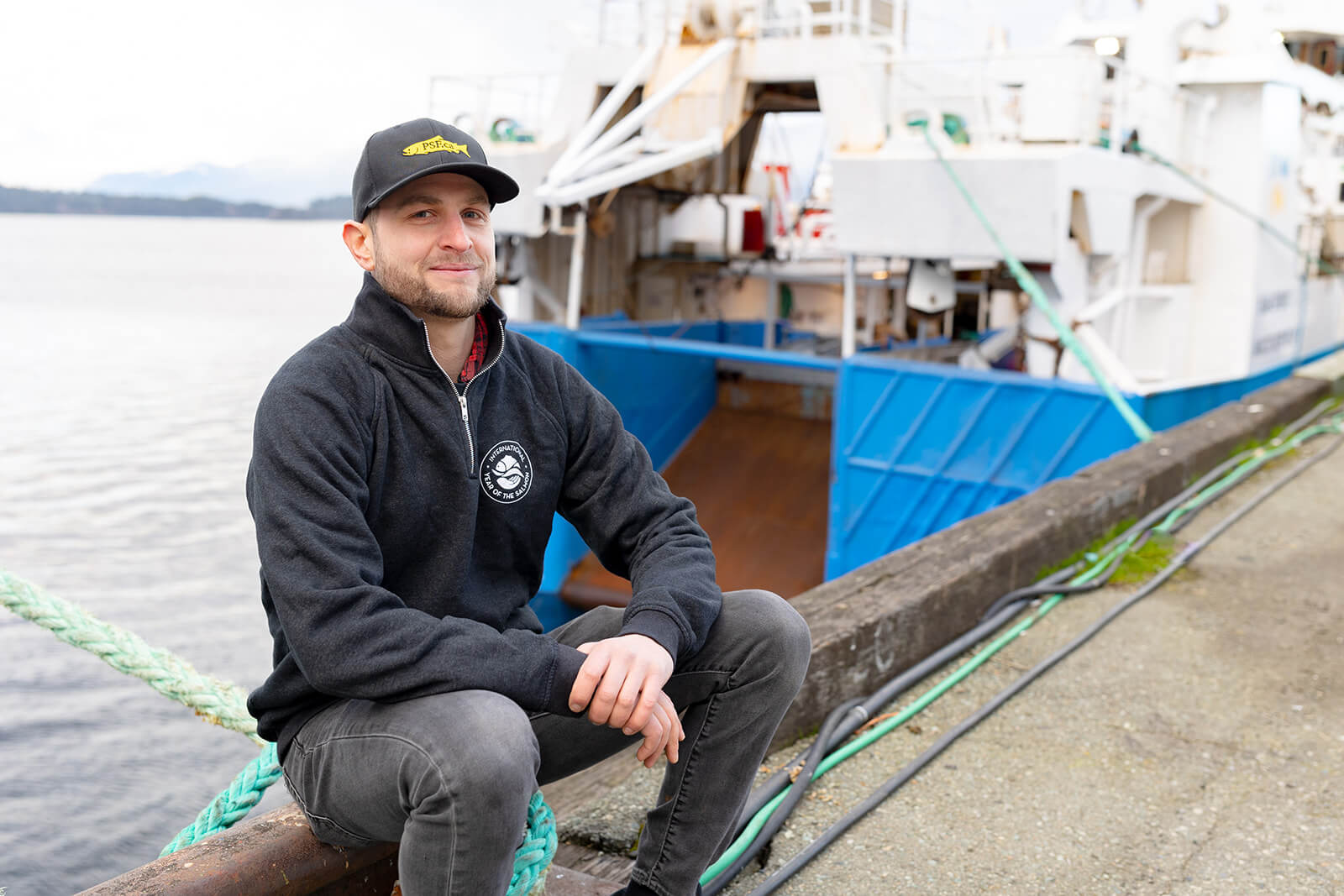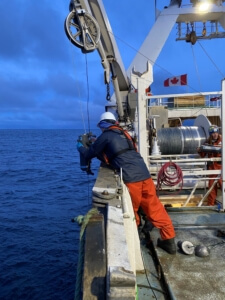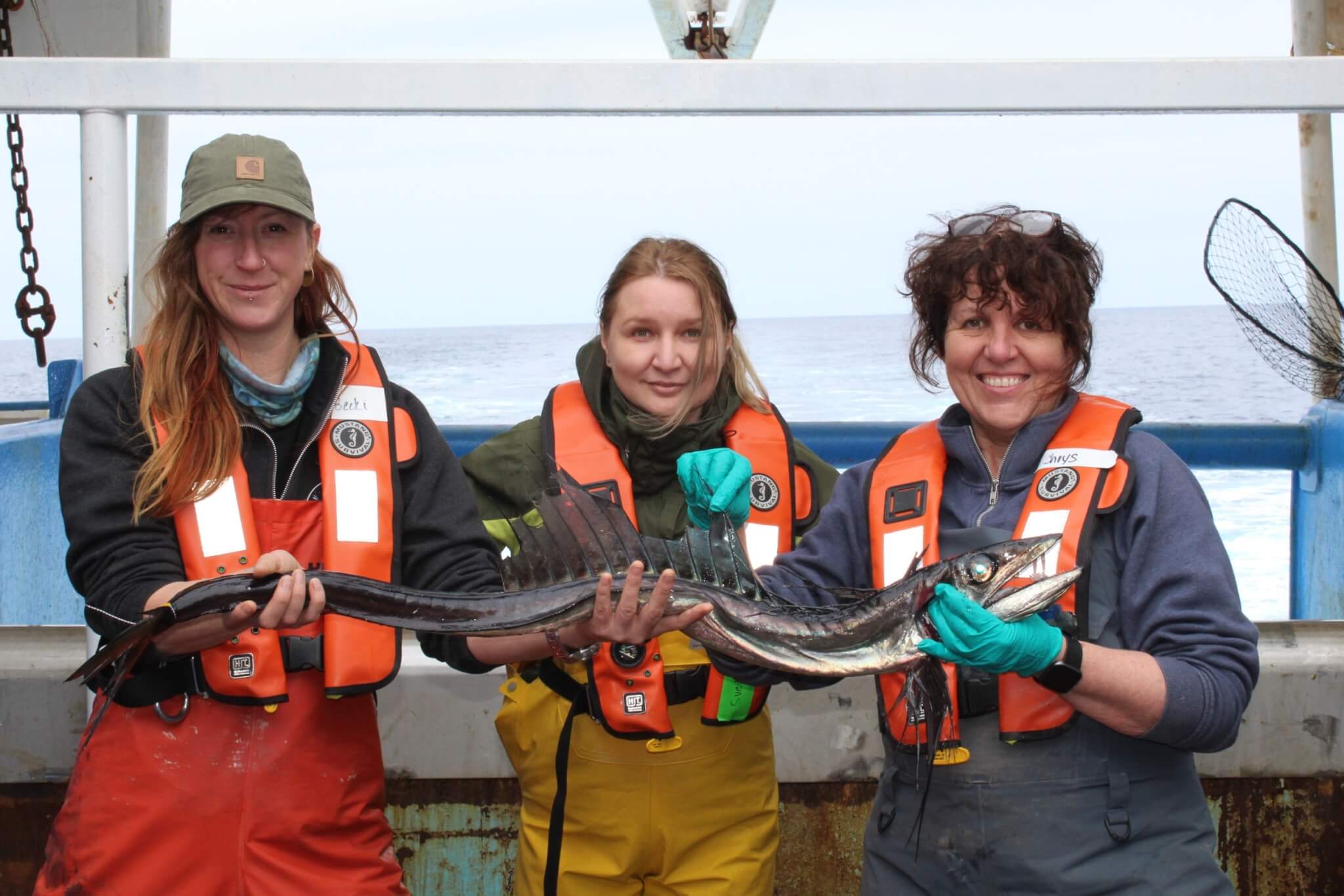Researchers use e-DNA to fill knowledge gaps in the Salmonosphere
Scientists use cutting-edge eDNA technology to decipher the challenges salmon face in the open ocean during winter.
Pacific salmon spend most of their life in the open ocean and face many challenges there, from finding prey to avoiding competitors and predators.
Yet salmon survival in the open ocean is poorly studied due to difficulties in collecting data on salmon and key organisms they coexist with in the high seas, including zooplankton, squids, sharks, whales, and jellyfish. This is especially true in the winter, when prey availability is linked to the survival of juvenile salmon.
Because all organisms leave behind invisible traces of DNA in the environment, salmon scientists can now collect and analyze such environmental (e)DNA samples to better understand the ecosystem salmon navigate at sea. This allows scientists to uncover the factors impacting salmon survival in the open ocean.
New peer-reviewed research from the Pacific Salmon Foundation (PSF)’s Salmon Health team published in Environmental DNA presents the findings from an eDNA survey performed in 2019 and 2020 in the Gulf of Alaska as part of the International Year of the Salmon (IYS), an initiative dedicated to conserving salmon in a rapidly changing world. The research provides novel insights into the winter Salmonosphere — the ocean environment as salmon experience it.
This study reveals the distribution of key organisms that share the dynamic and complex environment in which salmon exist. The eDNA analysis detects species not captured by conventional fisheries capture methods (e.g. large nets), confirms and improves previous species observations, and validates existing species distribution data.
“This ongoing research helps us understand the ‘black box’ salmon navigate in the North Pacific in the winter,” says Dr. Christoph Deeg, a researcher with PSF’s Salmon Health team and the lead author of the paper. “We are learning about the conditions salmon face and how those factors impact their survival. As we get new information, we will be able to better predict ocean survival and highlight conservation targets and management interventions.”

Dr. Christoph Deeg. (Alanna D Photography)
What can e-DNA tell us about salmon?

Sampling water for eDNA.
eDNA surveys involve collecting samples from the water column, extracting the DNA in a lab, and sequencing the DNA to determine what organism it belonged to from microorganisms to whales.
There are several benefits to eDNA. It eliminates the need to capture and handle animals through invasive sampling methods, something increasingly valuable in the context of threatened species, and it can detect elusive animals that are difficult to capture or see. It can also be relatively inexpensive, and the results are often more sensitive than conventional capture methods, thus adding a valuable new instrument for fisheries research.
“eDNA is undoubtedly becoming an essential tool to investigate salmon survival,” says Deeg. “It’s challenging to catch salmon in the open ocean in winter. That’s where eDNA is handy because we can almost always take a water sample, no matter how rough the sea or how queasy the waves make us.”
Deeg’s research illuminates several new findings about the winter Salmonosphere:
- Generally, the distribution of salmon captured in the eDNA survey confirms data from traditional catch data except in the case of pink salmon. Onboard the research vessels, catches of pink salmon remained below expectations for unknown reasons, despite pink salmon being the numerically dominant Pacific salmon species. The eDNA analysis, however, resolves the anomaly and supports a wider occurrence of pink salmon than indicated by trawl catches.
- Most salmon predators are skilled at evading conventional catch methods and are only occasionally spotted by visual observation. With eDNA, the researchers detected predators such as salmon sharks (Lamna ditropis), Dall’s porpoise (Phocoenoides dalli), and lancetfish (Alepisaurus ferox) as well cryptic but potentially abundant species such as beaked whales (Ziphiidae).
- Many salmon prey and competitor species in the open ocean – such as squids and lantern fish – complete daily a vertical migration. Because they are typically hiding in the deep ocean during the day and only come to the surface at night they are typically absent from net catches during the day. Their DNA, however, passively remains near the surface during the day, allowing researchers to detect these important prey for coho and pink salmon irrespective of the time of day.
- The study identified a negative co-occurrence relationship between chum salmon and northern sea nettle (Chrysaora melanaster), suggesting that chum avoid areas where these jellyfish are abundant. In 2019, this coastal species of jellyfish (melanaster) surprisingly surpassed salmon dry biomass by a factor of five. The jellyfish has previously been identified by researchers of PSF’s Salmon Health team as being associated with poor health of salmon, specifically chum and sockeye. The presence of the jellyfish could be an indicator of the unusual ocean conditions observed in 2019. A marine heat wave occured that year, which are known to have negative impacts on chum salmon.

Researchers on a high seas expedition for International Year of the Salmon holding a lancetfish. From left to right: Rebecca LaForge, Svetlana Esenkulova, Chrys Neville.
As the Gulf of Alaska ecosystem is expected to be transformed by climate change, this study provides a much-needed baseline. It demonstrates eDNA’s utility to complement and enrich conventional survey methods by offering a well-rounded view of the ocean ecosystem.
The researchers completed additional eDNA data collection on the 2022 Pan-Pacific International Year of the Salmon expedition. This latest survey deployed specialized and improved sampling systems that enabled semi-automated eDNA collection during travel, resulting in almost 1000 individual samples. They are currently analyzing the 2022 dataset.
This research is supported by Mitacs, Fisheries and Oceans Canada, and the Pacific Salmon Foundation. Dr. Richard Beamish led efforts to launch the International Year of the Salmon alongside PSF science advisor and former CEO Dr. Brian Riddell. PSF biologist Svetlana Esenkulova collected eDNA samples on the expeditions.



